Blog & Latest Updates
Fly Fishing Articles
Insects by Common Name


Smoky float down the Yakima Canyon
With limited weekends remaining for fishing before October gets really busy, my wife and I braved the smoke to float the Yakima Canyon from mile 20 down to Red's. We found very few steadily rising fish, just small ones sipping Baetid duns in a couple of spots, and picked up some rainbows up to 14" on miscellaneous attractor (Attractor: Flies not designed to imitate any particular insect, but to incorporate characteristics attractive to trout. When trout aren't feeding selectively, attractors often outperform careful imitations as searching patterns because they are easier to see and incorporate more strike-triggering characteristics. They include legends like the Adams, Bivisible, and Royal Wulff.) dries and nymphs. I've never seen so many deer along the canyon, perhaps a consequence of the fire burning out much of the adjacent habitat and feed a few weeks ago.
I did a fairly poor job of budgeting our time, stopping at every likely-looking seam early in the float and then having to blow through some of the best water in a rush to reach the landing before it was too dark to see. That's what I get for not learning the river yet. There were some nicer fish feeding at dusk and I missed a couple strikes, but I didn't have time to stick around and keep working on them.
Photos by Troutnut from the Yakima River in Washington
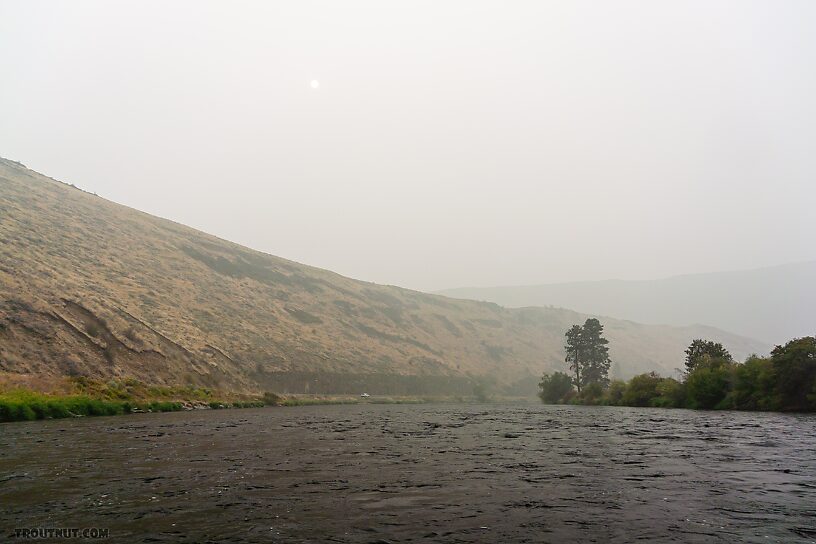
StateWashington
LocationYakima River
Date TakenSep 12, 2020
Date AddedSep 18, 2020
AuthorTroutnut
CameraNIKON 1 AW1
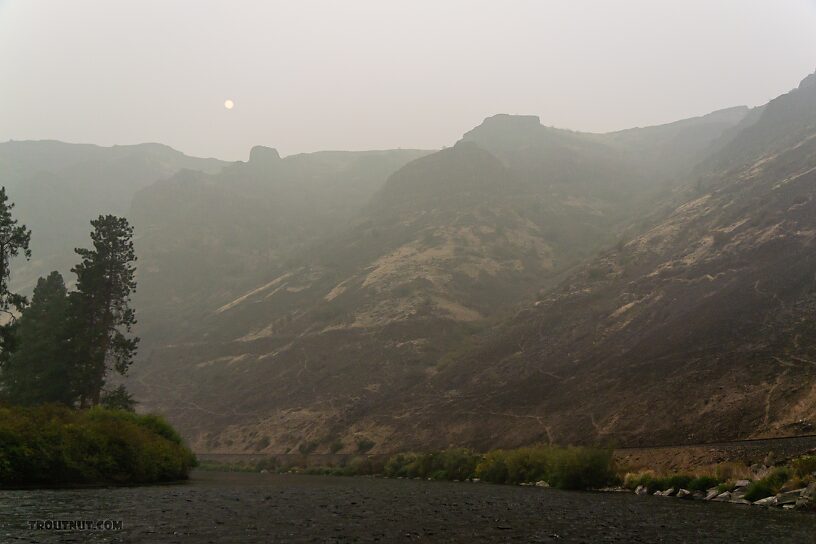
StateWashington
LocationYakima River
Date TakenSep 12, 2020
Date AddedSep 18, 2020
AuthorTroutnut
CameraNIKON 1 AW1
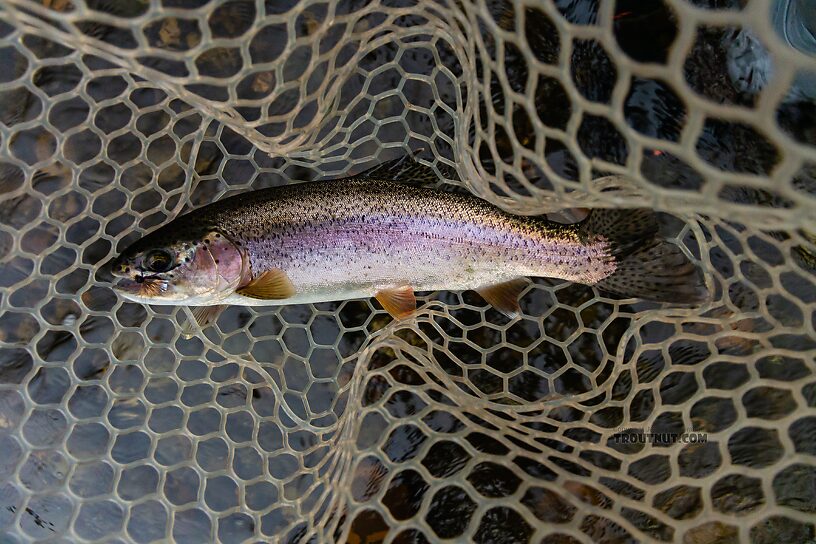
StateWashington
LocationYakima River
Date TakenSep 12, 2020
Date AddedSep 18, 2020
AuthorTroutnut
CameraNIKON 1 AW1
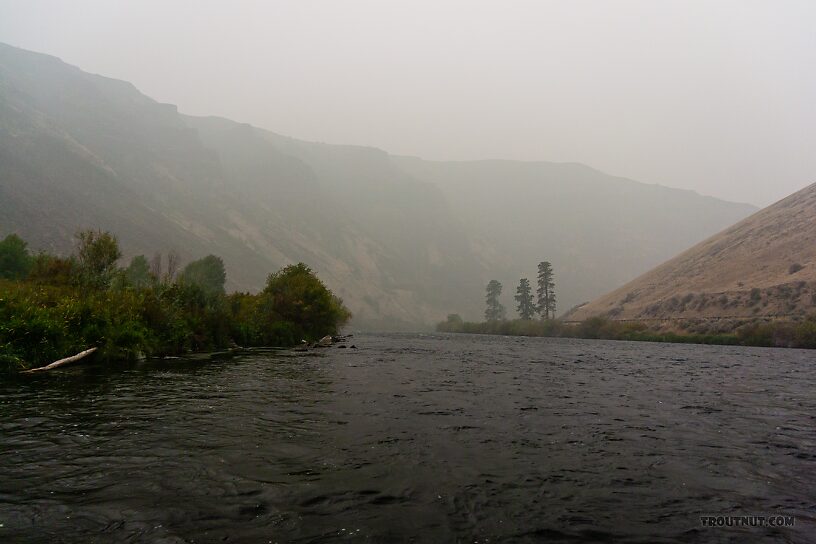
StateWashington
LocationYakima River
Date TakenSep 12, 2020
Date AddedSep 18, 2020
AuthorTroutnut
CameraNIKON 1 AW1
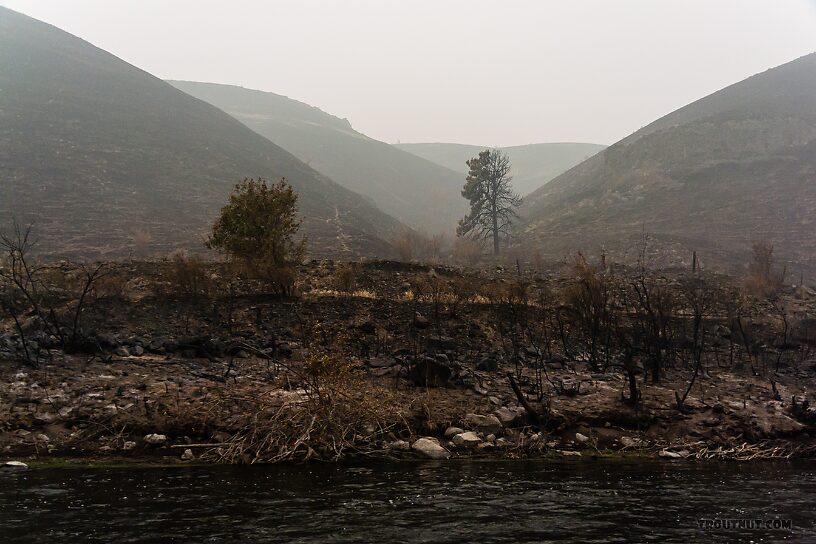
StateWashington
LocationYakima River
Date TakenSep 12, 2020
Date AddedSep 18, 2020
AuthorTroutnut
CameraNIKON 1 AW1
Closeup insects by Troutnut from the Yakima River in Washington
Brachycentrus americanus (American Grannom) Caddisfly Larva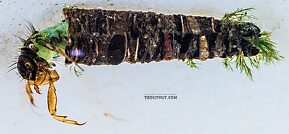 View 18 PicturesThis species of Brachycentrus was extremely common in mid-September kick net samples in the Yakima canyon.
View 18 PicturesThis species of Brachycentrus was extremely common in mid-September kick net samples in the Yakima canyon.
 View 18 PicturesThis species of Brachycentrus was extremely common in mid-September kick net samples in the Yakima canyon.
View 18 PicturesThis species of Brachycentrus was extremely common in mid-September kick net samples in the Yakima canyon.Collected September 12, 2020 from the Yakima River in Washington
Added to Troutnut.com by Troutnut on September 19, 2020
Added to Troutnut.com by Troutnut on September 19, 2020
Male Acentrella insignificans (Tiny Blue-Winged Olive) Mayfly Dun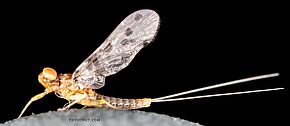 View 11 PicturesThis specimen emerged indoors from nymphs I had collected, then partly molted into a spinner but got stuck along the way. I've included a couple pictures showing some of the spinner colors. It got a bit waterlogged after emerging, so the wings aren't in perfect shape, but it still represents one of two Baetids that were emerging and drawing trout to rise on the Yakima. Based on body size and shape, it is most likely the same species as this nymph.
View 11 PicturesThis specimen emerged indoors from nymphs I had collected, then partly molted into a spinner but got stuck along the way. I've included a couple pictures showing some of the spinner colors. It got a bit waterlogged after emerging, so the wings aren't in perfect shape, but it still represents one of two Baetids that were emerging and drawing trout to rise on the Yakima. Based on body size and shape, it is most likely the same species as this nymph.
 View 11 PicturesThis specimen emerged indoors from nymphs I had collected, then partly molted into a spinner but got stuck along the way. I've included a couple pictures showing some of the spinner colors. It got a bit waterlogged after emerging, so the wings aren't in perfect shape, but it still represents one of two Baetids that were emerging and drawing trout to rise on the Yakima. Based on body size and shape, it is most likely the same species as this nymph.
View 11 PicturesThis specimen emerged indoors from nymphs I had collected, then partly molted into a spinner but got stuck along the way. I've included a couple pictures showing some of the spinner colors. It got a bit waterlogged after emerging, so the wings aren't in perfect shape, but it still represents one of two Baetids that were emerging and drawing trout to rise on the Yakima. Based on body size and shape, it is most likely the same species as this nymph.Collected September 12, 2020 from the Yakima River in Washington
Added to Troutnut.com by Troutnut on September 19, 2020
Added to Troutnut.com by Troutnut on September 19, 2020
Baetis tricaudatus (Blue-Winged Olive) Mayfly Nymph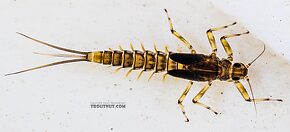 View 20 PicturesA nymph of the same species as this one emerged into a dun in my studio so I got photos of both stages.
View 20 PicturesA nymph of the same species as this one emerged into a dun in my studio so I got photos of both stages.
NOTE: I missed an important key characteristic the first time I tried to identify this one (robust setae (Seta: Little hairs on insects.) on the abdominal sternites (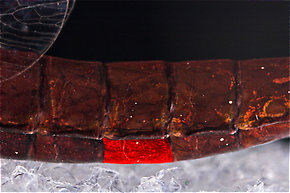 Sternite: The bottom (ventral) part of a single segment on an insect's abdomen.), which were harder to see than I expected but are clearly present), so I went on a bit of a wild goose chase and landed at a dead end. After spotting that characteristic, this one keys more straightforwardly to either Baetis tricaudatus or the Baetis piscatoris complex. It doesn't seem to be a perfect fit for either one in the key, but I'm going with tricaudatus based on range and abundance. It's not certain.
Sternite: The bottom (ventral) part of a single segment on an insect's abdomen.), which were harder to see than I expected but are clearly present), so I went on a bit of a wild goose chase and landed at a dead end. After spotting that characteristic, this one keys more straightforwardly to either Baetis tricaudatus or the Baetis piscatoris complex. It doesn't seem to be a perfect fit for either one in the key, but I'm going with tricaudatus based on range and abundance. It's not certain.
However, I'm leaving the flawed analysis below with this disclaimer, because some aspects of how I approached that dead end might be informative in the future.
----Incorrect analysis below----
After spending a lot of time with this one under my shiny new microscope, I'm still not quite sure what it is. I botched my attempt to expose the mouth parts that might make the ID more definitive. Based on the key in Webb et al 2018's "Baetis Larvae of North America," here's my reasoning at each key couplet.
Couplet 1. The pronotum (Pronotum: The top of the insect prothorax.) lacks dark, submedian U-shaped markings. Also, if I were to follow through to couplet 2, there seem to be characteristics that rule out each of the options: the intercalaris complex is ruled out by the abdominal markings, and the caudal (Caudal: Toward the posterior tip of the body.) filaments have neither a dark median band (ruling out the flavistriga complex) nor uniform pale coloration (ruling out Baetis notos). This sends me with decent confidence to couplet 4.
Couplet 4. I cannot find robust setae (Seta: Little hairs on insects.) in my microscope on the scapes, pedicels, paraprocts, or sterna. I also do not see a pair of dark, bilobed markings on the pronotum (Pronotum: The top of the insect prothorax.). Unless I overlooked these characteristics, proceed to couplet 9.
Couplet 9. Abdominal tergum (Tergum: the dorsal part of an abdominal segment or segments (terga). Also used to describe the entire abdominal dorsum or the thoracic dorsal segments of Odonata.) 5 is a bit paler than adjacent terga (Tergum: the dorsal part of an abdominal segment or segments (terga). Also used to describe the entire abdominal dorsum or the thoracic dorsal segments of Odonata.), but "distinctly paler"? The figure for Baetis alius in the paper, as well as a very nice picture posted by Millcreek in the forum here, shows that Baetis alius would have darker tergites (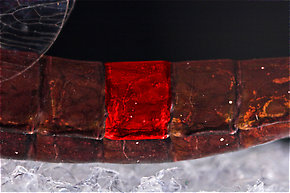 Tergite: The top (dorsal) part of a single segment on an insect's abdomen when it consists of a single chitinous plate (sclerite), or an individual sclerite if the segment has more than one.) surrounding #5. So proceed to couplet 11.
Tergite: The top (dorsal) part of a single segment on an insect's abdomen when it consists of a single chitinous plate (sclerite), or an individual sclerite if the segment has more than one.) surrounding #5. So proceed to couplet 11.
Couplet 11. The length of the gills is obviously less than 2X their width. This leads to the Baetis vernus complex, which could include that species or Baetis brunneicolor. This key doesn't say how to tell those species apart.
Switching over to Burien et al 2018 as the source, the characteristics used to distinguish vernus from brunneicolor seem to rule out either one. Brunneicolor should have more uniformly brown abdominal tergites ( Tergite: The top (dorsal) part of a single segment on an insect's abdomen when it consists of a single chitinous plate (sclerite), or an individual sclerite if the segment has more than one.), whereas vernus should have a lack of visible tracheation in most of the gills.
Tergite: The top (dorsal) part of a single segment on an insect's abdomen when it consists of a single chitinous plate (sclerite), or an individual sclerite if the segment has more than one.), whereas vernus should have a lack of visible tracheation in most of the gills.
The fore femur (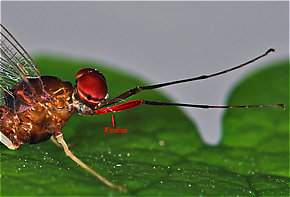 Femur: The main segment of an insect's leg close to the body, in between the tibia and the trochanter.) length is about 3.8x its width.
Femur: The main segment of an insect's leg close to the body, in between the tibia and the trochanter.) length is about 3.8x its width.
Also worth noting: In the genus ID, I thought I could see the villipore in my microscope, but I'm not sure. If I back out of Baetis altogether and assume there's no villipore, I end up at Fallceon, but this specimen doesn't seem to have the frontal keel on the head that's supposed to be present on Fallceon quilleri. So that seems like a dead end as well.
 View 20 PicturesA nymph of the same species as this one emerged into a dun in my studio so I got photos of both stages.
View 20 PicturesA nymph of the same species as this one emerged into a dun in my studio so I got photos of both stages.NOTE: I missed an important key characteristic the first time I tried to identify this one (robust setae (Seta: Little hairs on insects.) on the abdominal sternites (

One sternite of this Isonychia bicolor mayfly spinner is highlighted in red.
However, I'm leaving the flawed analysis below with this disclaimer, because some aspects of how I approached that dead end might be informative in the future.
----Incorrect analysis below----
After spending a lot of time with this one under my shiny new microscope, I'm still not quite sure what it is. I botched my attempt to expose the mouth parts that might make the ID more definitive. Based on the key in Webb et al 2018's "Baetis Larvae of North America," here's my reasoning at each key couplet.
Couplet 1. The pronotum (Pronotum: The top of the insect prothorax.) lacks dark, submedian U-shaped markings. Also, if I were to follow through to couplet 2, there seem to be characteristics that rule out each of the options: the intercalaris complex is ruled out by the abdominal markings, and the caudal (Caudal: Toward the posterior tip of the body.) filaments have neither a dark median band (ruling out the flavistriga complex) nor uniform pale coloration (ruling out Baetis notos). This sends me with decent confidence to couplet 4.
Couplet 4. I cannot find robust setae (Seta: Little hairs on insects.) in my microscope on the scapes, pedicels, paraprocts, or sterna. I also do not see a pair of dark, bilobed markings on the pronotum (Pronotum: The top of the insect prothorax.). Unless I overlooked these characteristics, proceed to couplet 9.
Couplet 9. Abdominal tergum (Tergum: the dorsal part of an abdominal segment or segments (terga). Also used to describe the entire abdominal dorsum or the thoracic dorsal segments of Odonata.) 5 is a bit paler than adjacent terga (Tergum: the dorsal part of an abdominal segment or segments (terga). Also used to describe the entire abdominal dorsum or the thoracic dorsal segments of Odonata.), but "distinctly paler"? The figure for Baetis alius in the paper, as well as a very nice picture posted by Millcreek in the forum here, shows that Baetis alius would have darker tergites (

One tergite of this Isonychia bicolor mayfly spinner is highlighted in red.
Couplet 11. The length of the gills is obviously less than 2X their width. This leads to the Baetis vernus complex, which could include that species or Baetis brunneicolor. This key doesn't say how to tell those species apart.
Switching over to Burien et al 2018 as the source, the characteristics used to distinguish vernus from brunneicolor seem to rule out either one. Brunneicolor should have more uniformly brown abdominal tergites (

One tergite of this Isonychia bicolor mayfly spinner is highlighted in red.
The fore femur (

The femur of this Isonychia bicolor mayfly spinner is highlighted in red.
Also worth noting: In the genus ID, I thought I could see the villipore in my microscope, but I'm not sure. If I back out of Baetis altogether and assume there's no villipore, I end up at Fallceon, but this specimen doesn't seem to have the frontal keel on the head that's supposed to be present on Fallceon quilleri. So that seems like a dead end as well.
Collected September 12, 2020 from the Yakima River in Washington
Added to Troutnut.com by Troutnut on September 19, 2020
Added to Troutnut.com by Troutnut on September 19, 2020
Male Acentrella insignificans (Tiny Blue-Winged Olive) Mayfly Nymph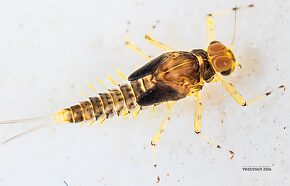 View 10 PicturesAnother nymph probably of the same species as this one emerged and was photographed as a dun and partly-molted spinner.
View 10 PicturesAnother nymph probably of the same species as this one emerged and was photographed as a dun and partly-molted spinner.
 View 10 PicturesAnother nymph probably of the same species as this one emerged and was photographed as a dun and partly-molted spinner.
View 10 PicturesAnother nymph probably of the same species as this one emerged and was photographed as a dun and partly-molted spinner.Collected September 12, 2020 from the Yakima River in Washington
Added to Troutnut.com by Troutnut on September 19, 2020
Added to Troutnut.com by Troutnut on September 19, 2020
Chironomidae (Midges) Midge Pupa View 9 Pictures
View 9 Pictures
 View 9 Pictures
View 9 PicturesCollected September 12, 2020 from the Yakima River in Washington
Added to Troutnut.com by Troutnut on September 19, 2020
Added to Troutnut.com by Troutnut on September 19, 2020
Dixidae True Fly Pupa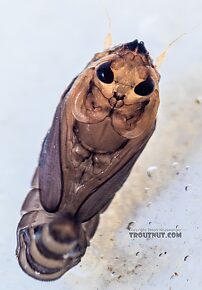 View 6 Pictures
View 6 Pictures
 View 6 Pictures
View 6 PicturesCollected September 12, 2020 from the Yakima River in Washington
Added to Troutnut.com by Troutnut on September 19, 2020
Added to Troutnut.com by Troutnut on September 19, 2020
Female Baetis tricaudatus (Blue-Winged Olive) Mayfly Dun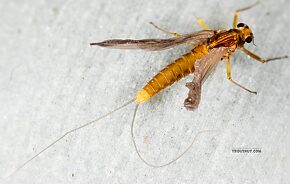 View 6 PicturesThis one emerged from a nymph of this kind in my studio but got a bit waterlogged before I could pull it out to photograph.
View 6 PicturesThis one emerged from a nymph of this kind in my studio but got a bit waterlogged before I could pull it out to photograph.
 View 6 PicturesThis one emerged from a nymph of this kind in my studio but got a bit waterlogged before I could pull it out to photograph.
View 6 PicturesThis one emerged from a nymph of this kind in my studio but got a bit waterlogged before I could pull it out to photograph.Collected September 12, 2020 from the Yakima River in Washington
Added to Troutnut.com by Troutnut on September 19, 2020
Added to Troutnut.com by Troutnut on September 19, 2020
Most recent comments on this post (latest on top)
Comment on this post
Top 10 Fly Hatches
Top Gift Shop Designs
Eat mayflies.
Top Insect Specimens
Miscellaneous Sites
Troutnut.com is copyright © 2004-2024 Jason
Neuswanger (email Jason). See my FAQ for information about use of my images.
 privacy policy
privacy policy
